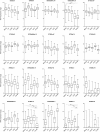A Cartography of Siglecs and Sialyltransferases in Gynecologic Malignancies: Is There a Road Towards a Sweet Future?
- PMID: 29594046
- PMCID: PMC5859025
- DOI: 10.3389/fonc.2018.00068
A Cartography of Siglecs and Sialyltransferases in Gynecologic Malignancies: Is There a Road Towards a Sweet Future?
Abstract
Altered surface glycosylation is a key feature of cancers, including gynecologic malignancies. Hypersialylation, the overexpression of sialic acid, is known to promote tumor progression and to dampen antitumor responses by mechanisms that also involve sialic acid binding immunoglobulin-like lectins (Siglecs), inhibitory immune receptors. Here, we discuss the expression patterns of Siglecs and sialyltransferases (STs) in gynecologic cancers, including breast, ovarian, and uterine malignancies, based on evidence from The Cancer Genome Atlas. The balance between sialosides generated by specific STs within the tumor microenvironment and Siglecs on leukocytes may play a decisive role for antitumor immunity. An interdisciplinary effort is required to decipher the characteristics and biological impact of the altered tumor sialome in gynecologic cancers and to exploit this knowledge to the clinical benefit of patients.
Keywords: The Cancer Genome Atlas; cancer immunotherapy; gynecologic malignancies; sialic acid binding immunoglobulin-like lectins; sialyltransferases.
Figures


Similar articles
-
The Distinct Roles of Sialyltransferases in Cancer Biology and Onco-Immunology.Front Immunol. 2021 Dec 17;12:799861. doi: 10.3389/fimmu.2021.799861. eCollection 2021. Front Immunol. 2021. PMID: 34975914 Free PMC article. Review.
-
Sialoglycans and Siglecs Can Shape the Tumor Immune Microenvironment.Trends Immunol. 2020 Apr;41(4):274-285. doi: 10.1016/j.it.2020.02.001. Epub 2020 Mar 2. Trends Immunol. 2020. PMID: 32139317 Review.
-
Hypersialylation in Cancer: Modulation of Inflammation and Therapeutic Opportunities.Cancers (Basel). 2018 Jun 18;10(6):207. doi: 10.3390/cancers10060207. Cancers (Basel). 2018. PMID: 29912148 Free PMC article. Review.
-
The Potential of Siglecs and Sialic Acids as Biomarkers and Therapeutic Targets in Tumor Immunotherapy.Cancers (Basel). 2024 Jan 10;16(2):289. doi: 10.3390/cancers16020289. Cancers (Basel). 2024. PMID: 38254780 Free PMC article. Review.
-
Siglecs family used by pathogens for immune escape may engaged in immune tolerance in pregnancy.J Reprod Immunol. 2023 Sep;159:104127. doi: 10.1016/j.jri.2023.104127. Epub 2023 Aug 3. J Reprod Immunol. 2023. PMID: 37572430 Review.
Cited by
-
Sialyltransferase-related genes as predictive factors for therapeutic response and prognosis in cervical cancer.PeerJ. 2025 May 22;13:e19422. doi: 10.7717/peerj.19422. eCollection 2025. PeerJ. 2025. PMID: 40416607 Free PMC article.
-
Salivary Transmembrane Mucins of the MUC1 Family (CA 15-3, CA 27.29, MCA) in Breast Cancer: The Effect of Human Epidermal Growth Factor Receptor 2 (HER2).Cancers (Basel). 2024 Oct 12;16(20):3461. doi: 10.3390/cancers16203461. Cancers (Basel). 2024. PMID: 39456554 Free PMC article.
-
Innate immune checkpoints for cancer immunotherapy: expanding the scope of non T cell targets.Ann Transl Med. 2020 Aug;8(16):1031. doi: 10.21037/atm-20-1816. Ann Transl Med. 2020. PMID: 32953831 Free PMC article. No abstract available.
-
Altered Cell Adhesion and Glycosylation Promote Cancer Immune Suppression and Metastasis.Front Immunol. 2019 Sep 6;10:2120. doi: 10.3389/fimmu.2019.02120. eCollection 2019. Front Immunol. 2019. PMID: 31552050 Free PMC article. Review.
-
Role of ST6GAL1 in Thyroid Cancers: Insights from Tissue Analysis and Genomic Datasets.Int J Mol Sci. 2023 Nov 15;24(22):16334. doi: 10.3390/ijms242216334. Int J Mol Sci. 2023. PMID: 38003522 Free PMC article.
References
-
- Allemani C, Weir HK, Carreira H, Harewood R, Spika D, Wang X-S, et al. Global surveillance of cancer survival 1995–2009: analysis of individual data for 25 676 887 patients from 279 population-based registries in 67 countries (CONCORD-2). Lancet (2015) 385(9972):977–1010.10.1016/S0140-6736(14)62038-9 - DOI - PMC - PubMed
LinkOut - more resources
Full Text Sources
Other Literature Sources

